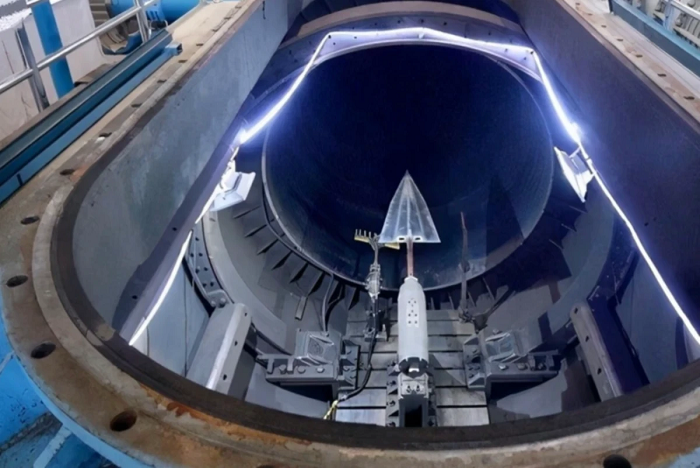ISABEL RUBIO ARROYO | Tungsteno
China claims to now have the world's most powerful wind tunnel. The stated goal of this cutting-edge facility is to contribute to a wide range of missions, including lunar expeditions with Chinese astronauts and the development of hypersonic aircraft able to reach anywhere on the planet within an hour.
We explore the wonders of this tunnel, which can simulate extreme flight conditions up to 30 times the speed of sound.
Flying at record speed
The tunnel is called JF-22 and is located in Sichuan, southern China. Construction began in 2018 and was completed in August 2021. "(We) have built the world’s largest free-piston driven expansion tube wind tunnel with high enthalpy," said researchers at the Hypervelocity Aerodynamics Institute, as reported by the South China Morning Post.
The Institute of Mechanics of the Chinese Academy of Sciences (CAS) in Beijing announced in June 2023 that its new JF-22 hypervelocity wind tunnel had passed an "acceptance check" and was ready for general use.
The tunnel spans 167 metres in length and can generate airflow velocities ranging from 2.5 to 11.5 kilometres per second.
The facility’s owners claim that it can simulate hypersonic flight conditions up to Mach 30, or 30 times the speed of sound. With a generous diameter of four metres, the tunnel accommodates larger objects for more accurate flight data.
As noted by Interesting Engineering: "The diameter of an intercontinental missile is also four metres, so researchers could practically put an entire missile inside and test the impact of sending it at speeds much higher than Mach 5."
The JF-22 can simulate airflow speeds up to Mach 30. Credit: Defense Formation.
The challenges of hypersonic flight
Wind tunnels are typically used to test new aircraft, missile and spacecraft designs. Some of the most powerful tunnels, apart from the one mentioned above, are NASA’s Hypersonic Tunnel Facility in the United States, which can reach speeds up to Mach 7, and the one at NASA Langley Research Center, which can achieve up to Mach 10.
The team behind the JF-22 claims that it can be used for various engineering projects, "such as the return capsule of the lunar landing project, entry into an alien atmosphere with an interstellar exploration aircraft and the development of hypersonic vehicles, such as scramjet-powered aircraft."
The first hypersonic flight took place in 1947, led by American pilot Chuck Yeager, a distinguished fighter pilot in the Second World War. Yeager conducted numerous tests with various aircraft until he accomplished the feat of breaking the sound barrier.
Subsequently, the aviation industry witnessed the development of increasingly advanced aircraft. Among them was the Tupolev Tu-144, hailed as the world's premier supersonic airliner. Its unveiling in 1968 marked a significant milestone in aviation history, particularly for the Soviet Union.
To achieve success, these aircraft needed to surmount various hurdles. Breaking the sound barrier often resulted in a thunderous sonic boom, creating significant noise pollution.
Additionally, the challenge of affordability was always an issue. Nowadays, supersonic flight remains predominantly within the realm of military aircraft, exemplified by the F-18 fighter jet.
The fascination with speed and space exploration has driven mankind to develop hypersonic aircraft and spacecraft. Credit: MSGT Ken Hammond
From hypersonic aircraft to spacecraft
While hypersonic aircraft are designed to fly within the Earth's atmosphere, there are craft designed to travel into space. In fact, the goal of the JF-22 wind tunnel is to "accelerate the development of a space-to-earth shuttle system," Jiang Zonglin, a researcher at the Institute of Mechanics and project manager of the wind tunnel, tells the Asia Times website. "If successful, the facility can also help reduce the cost of launching satellites and spacecraft by 90%."
Besides the inefficiency of conventional engines at hypersonic speeds, the transition in and out of the atmosphere at such velocities results in exceedingly high temperatures.
Therefore, it is essential to develop materials and thermal protection systems that can withstand these harsh conditions. It is still too early to say whether this tunnel will have a significant impact on the development of hypersonic technologies in the coming years.
Nevertheless, it is evident that wind tunnels like JF-22 serve as invaluable tools for simulating the extreme conditions of hypersonic flight, allowing engineers to test and refine their designs without endangering lives or spacecraft.
Tungsteno es un laboratorio periodístico que explora la esencia de la innovación.
